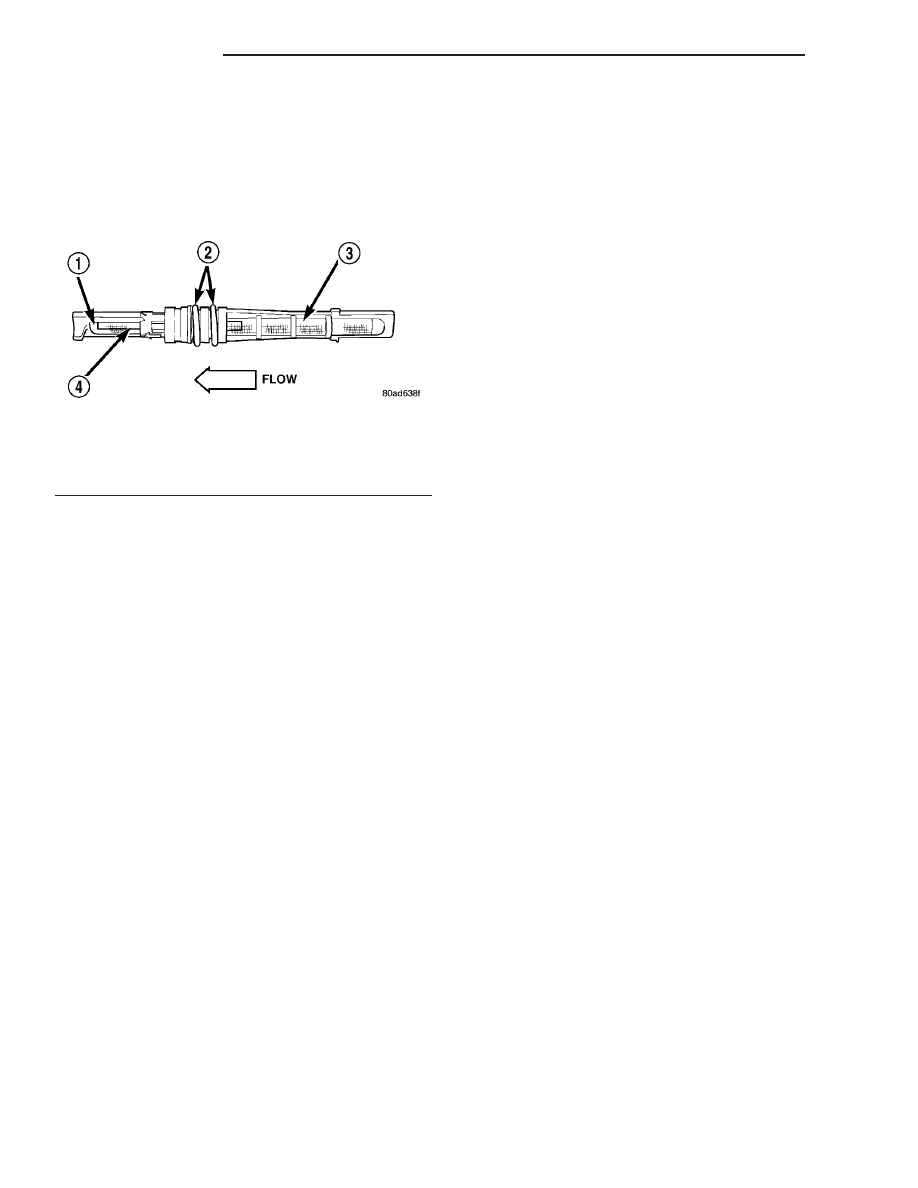Jeep Wrangler TJ. Manual - part 602

and helps to reduce the potential for blockage of the
metering orifice by refrigerant system contaminants
(Fig. 14). The outlet end of the tube has a nylon
mesh diffuser screen. The O-rings on the plastic body
of the tube seal it to the inside of the liquid line and
prevent the refrigerant from bypassing the fixed
metering orifice.
OPERATION
The fixed A/C orifice tube is used to meter the flow
of liquid refrigerant into the A/C evaporator. The
high-pressure liquid refrigerant from the A/C con-
denser expands into a low-pressure liquid as it
passes through the metering orifice and diffuser
screen of the A/C orifice tube.
The A/C orifice tube is not serviceable. It cannot be
repaired, and if faulty or plugged, it must be replaced
as part of the A/C liquid line (Refer to 24 - HEATING
& AIR CONDITIONING/PLUMBING/LIQUID LINE
- REMOVAL).
DIAGNOSIS AND TESTING
A/C ORIFICE TUBE
WARNING: The A/C liquid line between the A/C con-
denser and the A/C orifice tube can become hot
enough to burn the skin. Use extreme caution when
performing the following test to prevent possible
personal injury.
NOTE: The A/C orifice tube can be checked for
proper operation using the following procedure.
However, the A/C orifice tube is only serviced as a
part of the A/C liquid line. If the results of this test
indicate that the A/C orifice tube is obstructed or
missing, the A/C liquid line must be replaced.
(1) Confirm that the refrigerant system is properly
charged (Refer to 24 - HEATING & AIR CONDI-
TIONING - DIAGNOSIS AND TESTING - A/C PER-
FORMANCE TEST).
(2) Start the engine. Turn on the A/C system and
confirm that the compressor clutch is engaged.
(3) Allow the A/C system to operate for five min-
utes.
(4) Lightly and cautiously touch the A/C liquid line
near the condenser outlet at the front of the engine
compartment. The liquid line should be hot to the
touch.
(5) Touch the A/C liquid line near the evaporator
inlet at the rear of the engine compartment. The liq-
uid line should be cold to the touch.
(6) If there is a distinct temperature differential
between the two ends of the A/C liquid line, the A/C
orifice tube is in good condition. If there is little or no
detectable temperature differential between the two
ends of the A/C liquid line, the A/C orifice tube is
obstructed or missing and the A/C liquid line must be
replaced (Refer to 24 - HEATING & AIR CONDI-
TIONING/PLUMBING/A/C
LIQUID
LINE
-
REMOVAL).
ACCUMULATOR
DESCRIPTION
The A/C accumulator (Fig. 15) is mounted in the
engine compartment between the A/C evaporator and
the A/C compressor. An integral mounting bracket is
used to secure the A/C accumulator to the frame rail.
The A/C low pressure switch is mounted on a fitting
located on the top of the A/C accumulator.
The A/C accumulator cannot be repaired and, if
faulty or damaged, it must be replaced. The rubber
O-rings used on accumulator connections and the A/C
low pressure switch are available for service replace-
ment.
OPERATION
Refrigerant enters the A/C accumulator mostly as a
low pressure vapor through the inlet tube. Any liq-
uid, oil-laden refrigerant falls to the bottom of the
canister, which acts as a separator. A desiccant bag is
mounted inside the accumulator canister to absorb
any moisture which may have entered and become
trapped within the refrigerant system A filter is also
mounted inside the canister to trap any foreign mate-
rial that may have entered the refrigerant system
during assembly. The low pressure vapor exits the
A/C accumulator through the outlet tube.
The A/C accumulator cannot be repaired. If the A/C
accumulator is faulty or damaged, or if the refriger-
ant system has been contaminated or left open to the
atmosphere for an indeterminable period or if the
A/C compressor has failed, it must be replaced.
Fig. 14 Fixed A/C Orifice Tube - Typical
1 - DIFFUSER SCREEN
2 - O-RING SEALS
3 - INLET FILTER SCREEN
4 - ORIFICE
24 - 74
PLUMBING
TJ
A/C ORIFICE TUBE (Continued)